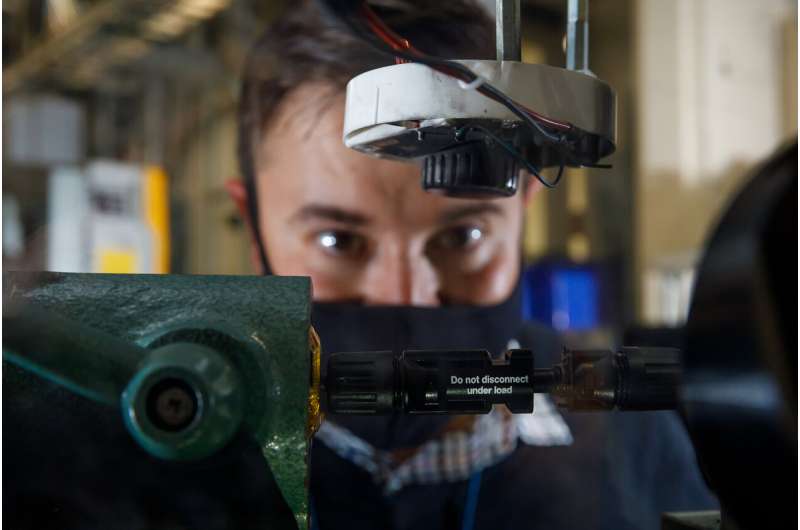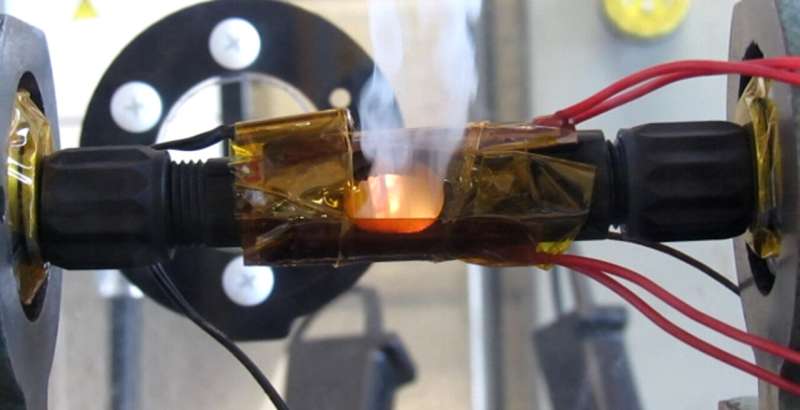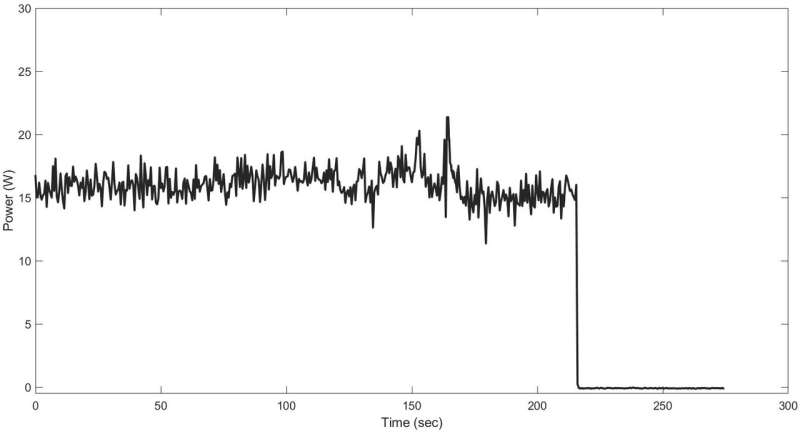Materials extinguish solar panel fires before they ignite

As solar panels become popular and their voltages increase, there is a need to have built-in capabilities to extinguish fires caused by arc-faults, which are high-power discharges of electricity that can create explosions or flash events due to damaged wires.
Sandia National Laboratories researcher Kenny Armijo has spent 10 years working alongside other researchers at the labs and local company Guardian Sensors Inc. to understand and characterize these hazardous arc-faults. Their work led to development of electrical in-line connectors that automatically predict and prevent photovoltaic arc-faults before they can ignite electrical fires.
"As solar panels become more efficient, they're able to produce more power," said Armijo. "More power means that they're going to have higher current and higher voltage levels. As you increase the current and voltage levels in next-generation solar panels, it becomes a bit more dangerous because as you increase the voltage, you get a higher propensity for arc-faults. This new self-extinguishing mechanism could solve that problem."
The in-line connector developed by Guardian Sensors—about an inch long and the diameter of a dime—contains a metal spring covered in a special type of self-extinguishing polymer material developed and tested at Sandia over the last five years. Like current connectors, the self-extinguishing mechanisms would link a series of solar panels like a string of Christmas lights that could operate together in a field or on a roof.
All connectors are susceptible to corrosion, damage or improper installation, which can lead to reliability issues, especially if there are tiny crevasses or breaks in the wires. Currently when this happens, sparks and devastating fires can occur when high current and voltage run through damaged connectors, and unfortunately, there isn't a completely reliable way for the connectors themselves to prevent the danger. That's where the new device would fill that gap, Armijo said.

The new in-line connectors have been built to activate at temperatures above 185 degrees Fahrenheit. When that happens, the special self-extinguishing material melts, fills in the crevasses or breaks in the wires and extends the spring which increases the spark gap between wire conductors, so they can no longer produce energy that leads to heat and fires. A combination of the speed of the reaction and the material's fire-resistant properties will stop a fire before it starts—in less than two seconds—Armijo said.
The self-extinguishing materials used in the connectors were developed from Sandia-based research originating out of the Laboratory Directed Research and Development program. Current work with Guardian Sensors is funded through the New Mexico Small Business Assistance Program that provides technical assistance from Sandia and Los Alamos national laboratories to companies seeking to solve scientific problems.
Through the NMSBA program, Sandia was able to provide Guardian Sensors access to a patented, special arc-fault generator located at the labs. It was developed by researchers working to determine how dangerous arc-faults are, and it can test different materials for reliability in high-voltage connectors and electrical wiring. For this project, Armijo was able to test a prototype of the connector for Guardian Sensors using the arc-fault generator, and results were successful.
Armijo has several photos, video and data from multiple tests. One significant example shows a graph of lines that increase as voltage spikes, "then bam—the self-extinguishing mechanism works," he said, pointing to where all lines on the graph make a sudden vertical decline to zero.
"You see this rapid shutdown, and it does it on its own," Armijo said. "To me, that is telling because it's effectively a set-it-and-forget-it kind of system. I think that's truly what makes this whole system really useful and impactful."

Company honored with prestigious awards
As a result of the technical assistance and success, Guardian Sensors received $225,000 and vouchers from the Department of Energy American-Made Solar Prize and provided research opportunities to three New Mexico universities. The company also was able to hire a new engineer and expand.
In addition, the company was awarded the Honorable Speaker Ben Lujan Award for Small Business Excellence that is presented to an NMSBA participant that demonstrates the most significant business growth for the betterment of the New Mexico economy through sustainability and workforce development.
"I highly recommend the NMSBA program because with technical assistance, we were able to test and validate the circuit interrupters," said program manager Kenny Blemel of Guardian Sensors. "We could not have accomplished this without the help of Sandia researchers and special equipment. We look forward to taking this to market for the benefit of companies providing alternative energy sources and for the public's safety."
In the future, Armijo said he hopes research can expand to other types of power sources and storage devices, like batteries.
"We're looking at expanding this research to more than just connectors," Armijo said. "I think the next step is seeing if we can extend something like this into energy storage, like batteries or anything that holds charge. At the end of the day, the way to make renewable energy work and be more adopted is to have storage, and Guardian Sensors and I are developing ideas and research around advanced energy storage technologies that will mitigate arc-faults."


















